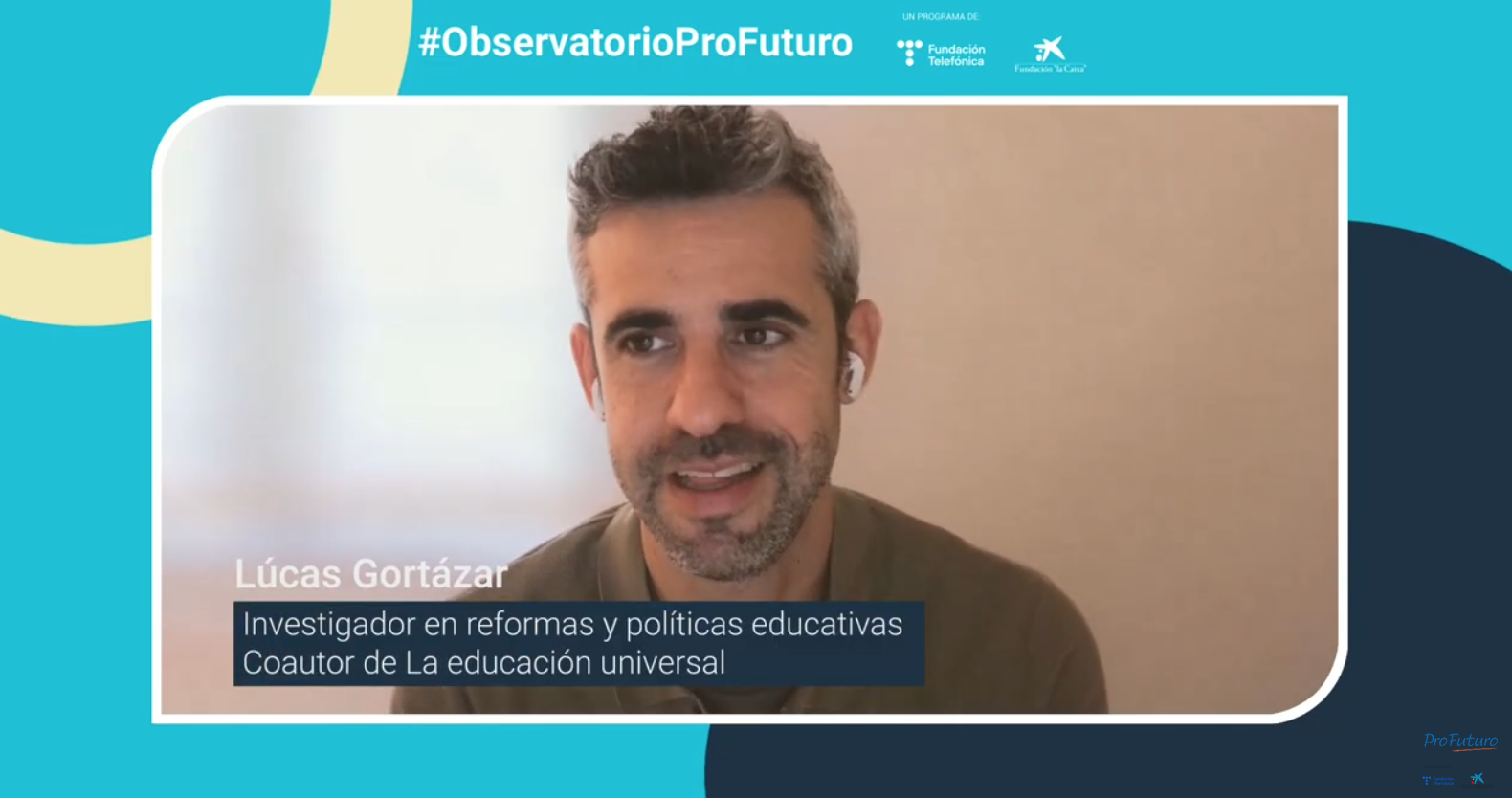Although we aren’t fully aware of it yet, artificial intelligence is transforming virtually every aspect of our daily lives. Education is no exception. How to harness it to improve teaching and close the educational divide is increasingly becoming one of the central points of the debate and the international agenda in the matter. It’s also one of ProFuturo’s strategic focuses. In this article we’d like to highlight some of the most important conclusions of the conversation between the two experts chaired by Maira Cabrini, head of communication and strategy at Ashoka Spain.
AI is still very limited in education
What’s the current situation of AI in education, particularly in the most vulnerable environments in which ProFuturo operates? Although the two experts were in agreement about the opportunities that AI and data science can bring to education in terms of releasing teachers from administrative burdens to enable them to focus on what’s important, analysing the evolution and level of the students, preventing truancy, etc., they agreed that the data currently at our disposal, especially in vulnerable environments, is very limited and fragmented: “There are lots of different systems that are compartmentalised. There’s no interoperability between the data and the system doesn’t have the capacity to use them effectively in real time”, explained Hawkins. “However”, stated Holmes, “the authorities around the world are rushing headlong into buying systems and spending lots of money, even though there’s little evidence of their effectiveness”.
Challenges and opportunities
As has been the case in other areas of society in which artificial intelligence has been applied for years, its use and development in education brings numerous opportunities and, of course, challenges. We’ve just mentioned the first of these: the data collection systems and their applications still need to be developed and refined. Let’s take a look at others:
Focusing on the problem: teaching skills
Technology isn’t a magic wand that will resolve the problems of teaching and the educational divide in vulnerable environments in one fell swoop. One of the consequences of the introduction of technology into the classroom is that it’s highlighted the new skills that teachers need, not only digital ones but also others related to digital pedagogy and how to teach effectively in online environments. According to Holmes, “we have to focus on the problems and not on the symptoms of the problems. The symptoms are that young people aren’t getting the education they deserve. But the problem is often that the teachers in these places are poorly qualified, poorly trained and with little experience, and we have to strive to improve and enhance these people’s qualifications, experience and competences in the classrooms”.
Can we do this with AI? We can and, in this regard, Holmes offered the example of an AI tool that can connect smallholder farmers in sub-Saharan Africa to enable them to pool their experiences, discuss the market and so on. Doing something similar to connect teachers could be an excellent way of using AI in education. However, “in the research world, there’s been almost no work on ways of using AI to directly support teachers. Only the use of AI to perform the teachers’ functions is being researched”. In order not to lash out blindly in the proper application of technology in education, it’s essential “to be sure about which problem we want to solve and not just focus on the symptom, going to the core of the problem and developing technology that allows us to deal with and resolve it”.
Equal opportunities are not enough
According to Unesco expert Holmes, “equity in education means recognising that equality of opportunities is not enough for all young people to reach their full potential. Limiting ourselves to giving the same opportunities to everyone doesn’t mean that everyone will get everything they can. Especially the most vulnerable children. In order to achieve everything they’re capable of, these kids need additional and faster support from us”. This is why it’s important to be precise in analysing the situation and quick but accurate in implementing the solutions. Technology, well-used, can be an essential ally.
The digital “tribe”
According to Hawkins, technology can bring links to the educational community that weren’t possible before, and this is precisely one of its “most effective uses”, namely forging human links. “Technology has the capacity to broaden the opportunities for teachers to access more networks, more knowledge and more contents so as to move away from the model whereby the teacher is the only source of knowledge and information in a classroom with 30 or 40 students. We need to find ways of enabling technology to help them in a number of ways: working in teams, connecting them with a mentor, helping them to learn more about other sources of knowledge and information and using data better to understand the students’ shortcomings and engage with them and their parents more effectively”.
The five principles of the use of EdTech in education
One of the fundamental questions at the heart of the EdTech debate is how technology can help to bridge the educational divide. And, more specifically, how to steer public policies and decision-making to achieve a long-term impact in education. In this respect, Hawkins spoke about five basic principles that every political leader should bear in mind when it comes to planning public policies in this area:
- “Ask yourself why”: what changes you want your investment to bring about, how the students’ skills will change, which dynamics between the teachers and students you hope to achieve and how this investment will enrich the curriculum. The more specific the educational outcomes and the changes in the classroom, the better. This is what drives investment in EdTech and not just technology.
- “On a grand scale and for everyone”: by focusing on the most disadvantaged and least connected and developing solutions to reach those people, schools, teachers and students, we can then broaden the scale to the socio-economically richer areas of a country. It’s both an outward and an inward task. This principle also includes the concept of person-centred design. Education ministers should attempt to understand how investments affect and meet the needs of teachers and students.
- “Empower the teachers”: Ultimately, education is a social commitment with the teachers at the heart of it. We need to find ways of supporting them so that they can do what they’re good at, namely stimulating the students and helping them with their problems, not just teaching a syllabus and marking exams. This sphere has the potential to enable technology to reduce the administrative burden, allowing the teachers to work in a different way. It also provides ways of placing them in contact with other sources of information, other networks and other teachers. We must attempt to ensure that technology enables the teachers to do their work more effectively.
- “Engage the ecosystem”: We acknowledge that EdTech has numerous dimensions. We can’t buy tablets and expect them to work their magic. We have to identify the sources of knowledge of the country or region and encourage the ministries of education to engage with these sources of innovation, whether they be universities, private sector service providers, NGOs or other government agencies. The whole ecosystem needs to be addressed and harnessed as a support network for education.
- “Be data-driven”: There are great opportunities to use data more effectively, not only to measure the impact on the system, but also to analyse the learning and learning outcomes. Moreover, the idea of using data and evidence on a global scale helps ministries not to reinvent the wheel but to engage with this large ecosystem and adopt an innovative approach. Thus, the ministry of education will be a learning organisation that tests new procedures and collects data on them in order to adapt their application.
In short…
In a single sentence, what would we ask of the heads of our educational policies? According to Holmes, the recommendation would be “not to be seduced by the hype and siren calls concerning AI. There are very effective tools, but we must also be very careful about not limiting ourselves to creating tools that automate bad pedagogical practices”. Hawkins underlined his first principle: “Ask yourself why. The reason for each investment, what’s going to change, what you want to happen in the system and the classroom and in the involvement in the link between the student and the teacher, between the teacher and the parents and between all of them and the community”.
In short, technology, AI and data science can help us to improve education and minimise the educational divide. But this must be done by carefully analysing the situation, asking the right questions and seeking meaningful solutions. The education of tomorrow lies in our hands today.
If you want to find out more about all these issues, you can watch the full interview here.






